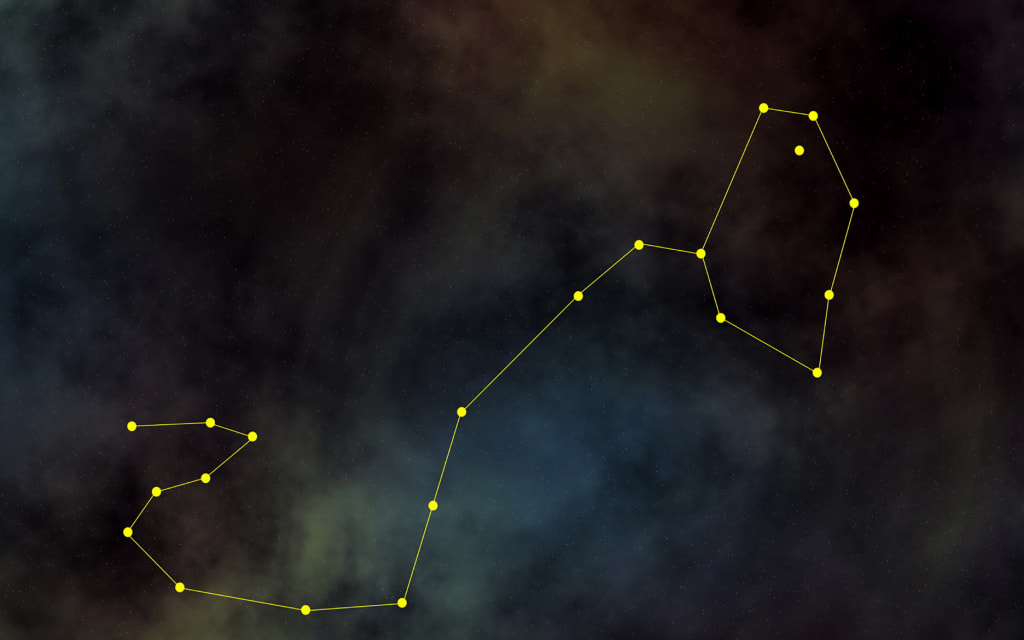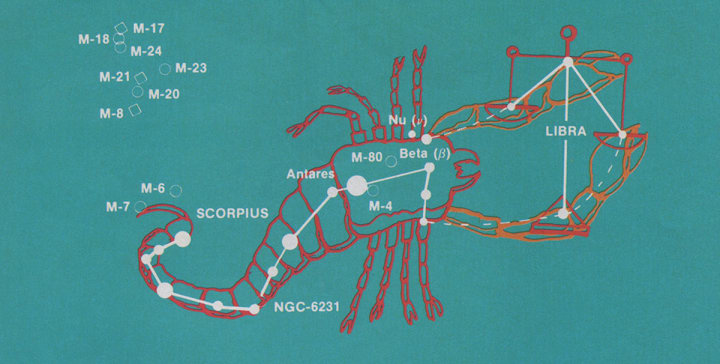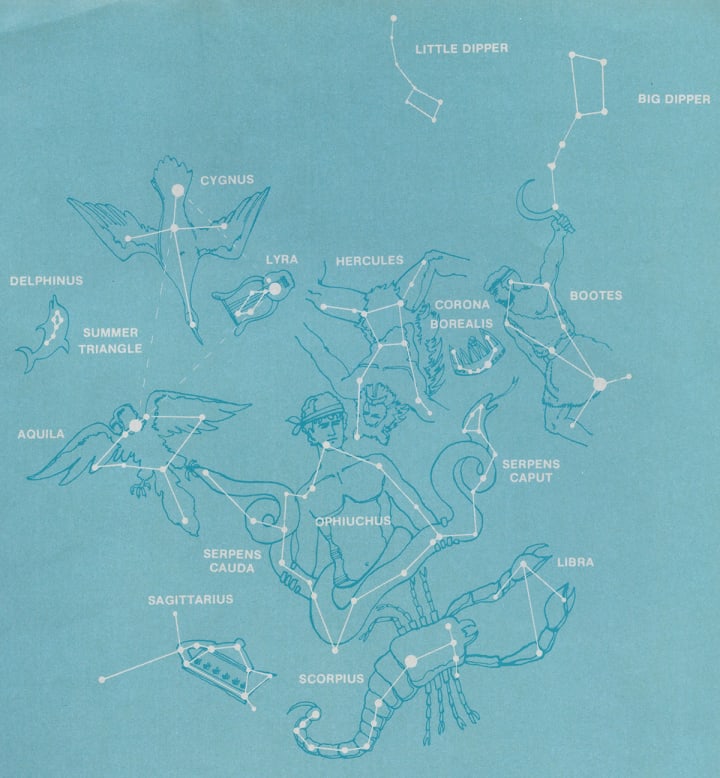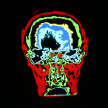Finding Scorpius Constellation
Once you find Scorpius, you open the door to finding many other constellations in the solar system.

Scorpius' claim to fame lies in its poisonous sting. The great hunter Orion boasted that he could wipe out all the creatures of the Earth. Gaia, the goddess of the Earth, realized how lonely our planet would be without the birds and beasts, so she sent a giant scorpion to attack the bragging hunter. In the terrible battle that followed, Orion killed the scorpion, but not before he was fatally stung.
Zeus, king of the gods, found Orion and Scorpius so remarkable that he gave them places of honor among the stars. To prevent trouble in the future, Zeus set them in opposite ends of the sky. You may remember that Orion appears high in January. Six months later, Scorpius prowls the southern horizon. We can see the last of Orion disappear in the west just as Scorpius rises in the east.

Searching for Scorpius
Scorpius is easy to identify, since it really does look like a scorpion. To find it, face south about 10 PM toward the middle of the month. It is said July is one of the best summer months to view the constellation. Near the horizon you'll find the bright red star Antares, the heart of the scorpion. Down and to the left of Antares is the scorpion's tail with the stinger raised to strike. Above and to the right is the row of stars that marks the scorpion's head.
We can use Scorpius to find Libra, the scales. Two bright stars mark the right edge of this constellation. Many centuries ago, Libra marked the scorpion's claws. Think of the scorpion reaching to pinch Virgo.
Antares was one of the four royal stars of the Persian astronomers, along with Regulus in Leo (seen in spring), Fomalhaut in Piscis Australis (autumn), and Aldebaran in Taurus (winter). Antares means rival of Mars. We can easily see how the star got this name by comparing it to the Red Planet. Mars is in the line of planets that points almost directly at Antares. Now heading toward Scorpius, Mars will appear to wait for Antares as the constellations move west through the sky. By September the planet will lie near Antares on the western horizon at sunset.
Besides being beautiful to the naked eye, Scorpius contains great sights for binoculars, small telescopes (2 to 3 inches), and larger telescopes (4 to 6 inches). Double star buffs should look above and to the left of Beta for Nu. Nu easily splits in two with binoculars; a large scope at high powers might show as many as four stars. Some say Nu is the most beautiful quadruple in the sky. A small scope will show that Beta itself is a double; it's triple with a large scope at high powers. And Antares is a double, but only a large scope at high powers will show this.
Scorpius marks the western edge of an area containing lots of nebulae and star clusters. If you go camping or can take a night drive into the countryside, look for the star clusters M-6, M-7, and NGC-623. All three can be seen as fuzzy patches with the naked eye in very dark skies. Slightly dimmer than these are two more clusters, M-4, next to Antares, and M-80, between Antares and Nu. All of these objects are amazing with binoculars, and just get better with larger telescopes (at low powers).

Constellations in Summer Skies
Warm, lazy July nights are great for learning and viewing the summer constellations. Spread a blanket out in the backyard and lie on your back with your feet facing south.
Find the Big Dipper high over your head on the right. We can use this all-purpose finder constellation to start our stargazing expedition. Now, follow the curve of the Big Dipper's handle down toward your right shoulder. This nifty maneuver, called “arcing to Arcturus,” will lead to the bright yellow star Arcturus. This is the bottom of the large constellation Bootes, the herdsman. Bootes curves up and left from Arcturus and is about as long as the Big Dipper. It looks a lot like a narrow kite.
Just to the left of Bootes is a small but lovely constellation, Corona Borealis, the Northern crown. The Crown is about as big as the Big Dipper's bowl. It's not too bright, but it's easy to spot in the city—it really looks a lot like a crown.
Move to the left again to find Hercules, the greatest hero of the Greek legends. Look for a square of faint stars about the size of the Crown. This is the “keystone," Hercules' great chest. The keystone is also about the size of the Big Dipper's bowl, but the entire hero is longer than the Dipper.
If the sky is very dark, you might see a fuzzy glow on the right side of the keystone. That's the famous star cluster M-13. This huge ball of over 300,000 stars sends its light from more than 25,000 light years away (that's more than 237,000,000,000,000,000 kilometers!!). Even in the city, this amazing sight can be found pretty easily with binoculars.
Below Hercules is Ophiuchus, who lives a doubly dangerous life: he's standing on the scorpion while holding Serpens, the snake! This very large constellation (the 10th biggest) fills the big gap between Hercules and Scorpius. Serpens is so long that astronomers divide it in two. Serpens Cauda (the tail) stretches left from Ophiuchus to Aquila; Serpens Caput (the head) lies just below Corona Borealis. If you have trouble identifying these two large constellations, save them for last. Once you know the surrounding constellations, Ophiuchus and Serpens will be easier to find.

Image via WikiHow
The Summer Triangle
To the left of Hercules is the most famous feature of summer, the Summer Triangle. It's made up of three bright stars: Vega in Lyra, Deneb in Cygnus, and Altair in Aquila. This is a great sight to share at a July star party, especially since it helps people find those three constellations.
Lyra is a rather small constellation - it could fit in the Big Dipper's bowl. You'll have to look hard to see the four stars below Vega, but when you find them, Lyra might remind you of a harp.
Cygnus the Swan is a lot larger than Lyra (about as big as Bootes). you'll find its main stars easily. Bright Deneb, the northernmost star, is the tail of this heavenly bird; bright Albireo far to the south is its head, when you look for Albireo, remember that swans have long necks. Think of a huge goose flying south for the winter! The wings spread far to the sides of Deneb. This constellation is sometimes called the Northern Cross.
Aquila the Eagle is about the same size as Cygnus, but its shape is almost the opposite. Bright Altair marks the head of this hunting bird. Its wings are on either side of its head. Aquila and Cygnus are flying in opposite directions along the Milky Way. If you can see the Milky Way from your observing site, think of Cygnus and Aquila flying down opposite lanes of a two-lane highway. Now try to find the black line down the middle of the road. The line starts below and to the left of Deneb. This dark streak in the Milky Way is known as the Great Rift. It's a region of dust which hides all the distant stars that give this area its milky glow. Look for the small constellation Delphinus the dolphin between Cygnus and Aquila. It looks a lot like a dolphin leaping out of the water.
Follow the Milky Way all the way south to find Sagittarius. Sagittarius shares the southern horizon with Scorpius; look to the left of the scorpion's tail. Sagittarius has been known for centuries as the Archer, but its main stars remind modern observers of a teapot. Between the teapot and Scorpius is a region chock full of deep sky objects. If you scan this area with binoculars, you'll probably run across several star clusters.
About the Creator
Futurism Staff
A team of space cadets making the most out of their time trapped on Earth. Help.






Comments
There are no comments for this story
Be the first to respond and start the conversation.